Your Cart is Empty
by Chris Thomas April 14, 2020 9 min read

Knowing your pond volume is essential when keeping koi. From planning through to stocking and treating, having an accurate measurement of your proposed or actual pond capacity is essential for planning equipment needs, how many fish you can keep in good condition, and to make sure you don’t overdose on treatments. In this blog post we will look at three methods for measuring your pond volume, covering options for formal ponds and irregular shapes.
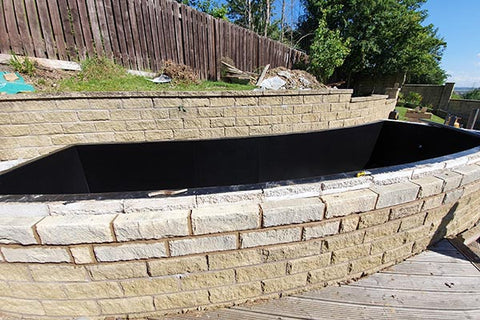 |
|
An irregular shape pond can prove tricky to calculate the pond volume accurately
|
A good koi pond should be planned from the start, with equipment to match the planned pond size. If you know the volume of your planned pond, you can plan for the right amount of bottom drains, skimmers, and returns, as well as the correct filters, pumps, UV’s, and air pumps. If you get the pond volume and the equipment balance too far out at this stage, it will make keeping koi difficult, costly to rectify, or be harmful to your koi collection.
 |
 |
| Filters must be matched to pond volume |
Know your pond volume to correctly size equipment
|
When you have your pond running, it's inevitable that at times you will want to treat your pond for things like blanketweed and parasites. If you don’t have an accurate measure, you will not know how much treatment to purchase and use. If you underdose, then you are wasting time and money as the treatment is likely to be ineffective. If you overestimate you pond volume and add too much treatment, then you are also wasting money, but also risking damage or worse to your koi.

|
|
Treatments like Potassium Permangantate need to be dosed accurately. If you make bad estimations of your pond volume, you could harm your koi.
|
As well as working out the volume of your pond for equipment and treatments, some of the methods below can easily be adapted to work out things like materials and cost for liners, fibreglass, blockwork, and other quantities you may need when planning/building your dream pond.
Before we look at our methods for working out pond volumes, it’s worth knowing some simple conversions that will make it easy to work out litres or gallons, whether your pond is measured in metres or feet.
Let’s look at the 5 ways to estimate your pond volume
Working out your pond volume from plans works best for regular shapes – square, rectangle, circle, and triangle shapes can easily be measured from dimensions.
You can even work out shelves, and tapered pond walls with maths – you might want a pencil, graph paper, and calculator but it’s quite easy if you have a flat bottom, and curves that are roughly uniform.
If you have a square or rectangular pond, then it’s as simple as
Length x Width x Depth x Volume Multplier
So for an example, lets take an average wooden/sleeper pond build, measuring 8ft x 8ft x 4ft deep. For this example I will ignore the thickness of the sleeper and assume the measurement is internal/finished sizes.
8 x 8 x 4 x 6.25 = 1600 gallons
To convert to litres,
1600 gallons x 4.54 = 7264 litres
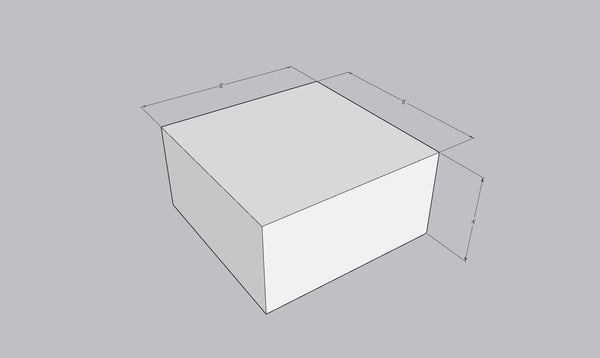
Round ponds aren’t quite as common, but round vats make excellent small ponds as they gain a lot of strength from their shape. To calculate the capacity of a round pond, we need
For this example, I will use metric measurements, and calculate the volume of our pond in litres first. The last tank I moved and set up with a customer was 1.5m across (diameter, we need the radius so half this figure) and 0.9m deep.
To convert to gallons,
1591 litres / 4.54 = 350 gallons

However, most of these plastic round containers have tapered sides, and are wider at the top than they are at the bottom. Measuring from the top only will cause you to over estimate the pond volume. If this is the case, then measure the diameter at the top and bottom, and take the average diameter.
For a round pond with depth of 1.2 metres, and a diameter of 3.2 meters at the top, and 2.9 meters at the bottom, it would work out like so
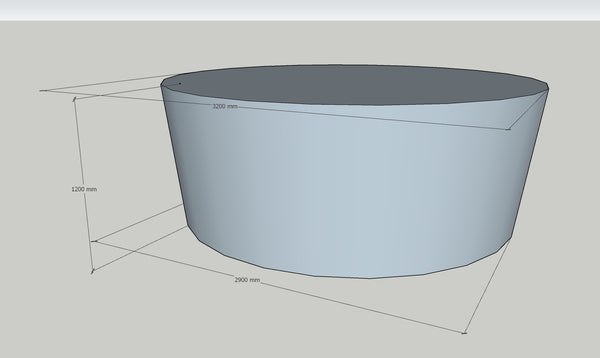
What if the pond has shelves, or an L shape?
It’s not too difficult if like the above examples, you have flat bottoms and uniform sides (not necessarily straight, as we proved above it’s simple to work out a sloped wall).
For this next example lets take our sleeper pond from above, and extend it without digging. Our example pond is 16ft x 8ft, with half the pond being 4ft deep and half being 2ft deep. To calculate the volume, we could do this one of two ways – either calculate the average depth like we calculated the average diameter in our circular example above, or by splitting the pond in to two sections.
Splitting the pond in two, we would do the following sums,
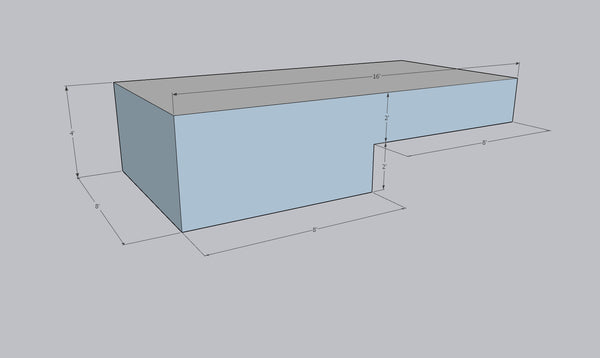
Due to the many variations in triangular ponds, it’s worth looking at our second method for calculating the volume, unless you have a 90 degree corner and straight sides.
If you have triangular pond with a 90 degree angle, you can work the volume out as a square, using the two shortest dimensions as your length and width, and dividing the total by 2.
If it is not this simple, then by using an online calculator to work out the area of the base, we can easily work out the volume by multiplying the area of the base by the depth, and the volume multiplier.
To illustrate, if you have your base area as 11.15 metres, with a pond depth of 1.4 metres, your pond volume will be
11.15 x 1.4 x 1000 = 15610 litres or 3438 gallons

Online pond volume calculators offer the same solutions as above, but faster, and are less reliant on your own math skill! Some calculators will also work out pond liner size, or quantities for fibreglass lining. When using these calculators, carefully check what format your measurements need to be in – if you enter millimetres instead of metres then you will be far from your true volume!
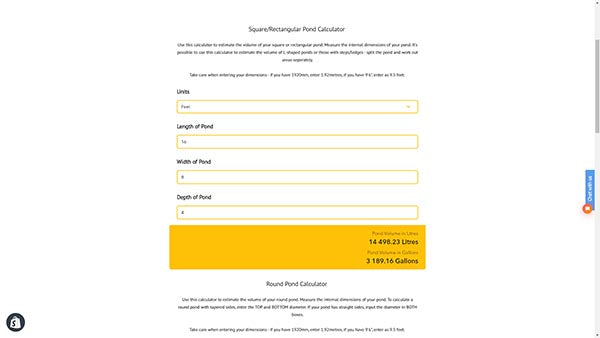
We have a pond volume calculator, which can be found here.
Working our irregular ponds can be tricky, if not near impossible without advanced maths. One trick for working out irregular ponds is the use of a design or CAD program. When designing ponds and working out quantities when planning pond builds from sketches, we will use Sketchup to make a 3d model of the plans.
When using such programs, you can draw out the shape of the pond using a variety of shape and line tools to create an accurate model, or plans for the builder to follow. Each shape that you draw has a property panel, where you can see information such as surface area.
If you take this measurement, and carefully convert to a useful unit (by default, my settings give me the area in mm2), you can then multiply by the depth of the pond to give the volume, and convert by the multiplier to give the litres/gallons.

The best and most accurate method of working out the volume of a pond is by filling the pond with a water meter. The above methods can only estimate the volume of the pond, and although you can be extremely keen and work out the volume of your pipes and fittings, you will still be calculating them by the time the pond has filled.
Water meters are available to purchase from builders merchants, eBay, and Amazon. Often they will come designed to fit on 15mm copper pipe – a couple of fittings and you can easily fit them on to a garden hose when filling your pond. It’s also useful after filling the pond if you keep it inline with your water purifier to measure the amount of water used, for gauging when to change purifier cartridges.
When filling with a water meter, take the reading from the meter before starting, especially if it’s a borrowed device. Most water meters will have a roller counter (like a car odometer), and a series of dials like a clock face. The main roller counter measures cubic metres (1000 litres/220 gallons). The clock faces measure 10ths, 100ths, 1000ths and 10000ths, these represent 100l, 10l, 1l, and 0.1l respectively.
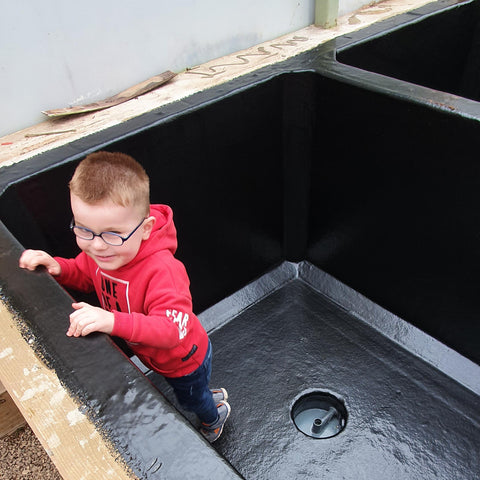 |
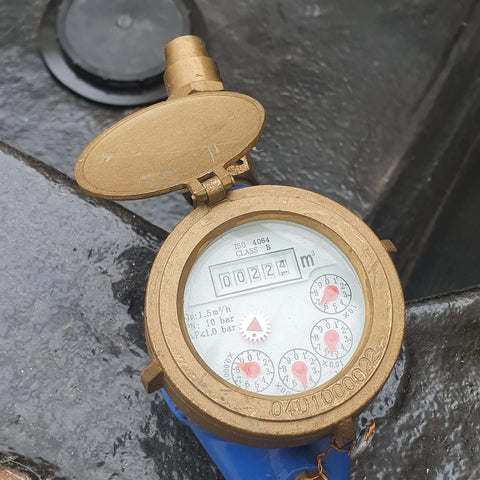 |
 |
| Using a water meter to accuratly measure volume | Meter reading taken before filling 4 new koi ponds |
Meter reading following the filling of our new sales ponds
|
By taking a reading before and after, and working out the difference, you can take the most accurate reading of your pond volume possible. This measurement will take in to account the shape of the pond including and curves, benching, shelves, and taper, as well as the bottom drain and pipework, the filter, pumps, UV’s, and heaters.
The 2 images above were the actual readings from our 4 outdoor tosai ponds. Looking at the roller counter and dials, our start reading was 224.6548, and our final reading was 232.5723.
I am not mad keen on the use of salt in koi ponds. I use it when new fish arrive, and that’s about it. However, there is one amazing use for salt that will help people that didn’t know know to use a water meter when first filling their pond. This will help get you an accurate estimation of our pond volume without affecting the fish, without draining down, and will definitely help if you have an irregular pond or lots of pipework and equipment.
To estimate a pond volume using salt, you need a good set of weighing scales, PDV salt, and an accurate salt meter, like the Salt Medic.
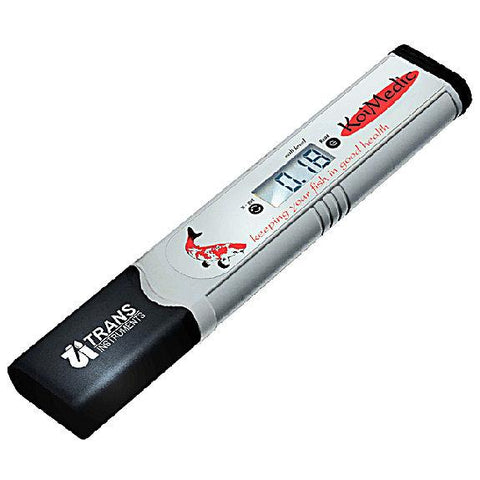 |
| Koi Medic Salinity Tester / Salt Meter for Koi Ponds |
The first thing to do is work out approximately how much salt would be appropriate to add to the pond. Using method 1-3, work out the volume of the pond to the best of your abilities. We want to aim for a salt concentration of 3 ppt - 3kg per 1000 litres. At this level, we can safely dose most koi and pond treatments after a small water change to reduce the salinity.
Now you have your estimated pond volume, we need to work out how much salt to add to the pond. For our example, lets say our estimation is 14500 litres. To reach a salinity of 3 ppt we would need 43.5kg of PDV salt.
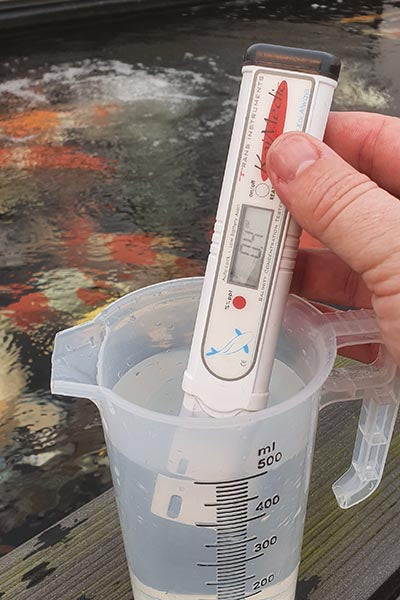
First, we must take a sample of water from the pond and test the salinity. Even if you have never used salt, you will get a reading. Write this down – it will most likely be 0.1.
Add the 43.5kg of PDV salt, and take the salinity reading the following day. Record the reading, and we can begin to estimate the pond volume.
If your first reading was 0.1 ppt, and the second reading was 3.3, and we added 43.5kg of salt, we can estimate the pond volume,
First we take the change in salinity,
Then
You can see from this example that we were close with out estimation, but our irregular pond shape wasn’t a perfect rectangle (so we lost actual volume), and we didn’t include filters (we didn’t include this in the calculator).
Due to the resolution of the salt meter, it’s wise to put in as much salt as you can, safely.
For example, our reading of 0.1 could be rounded up or down, giving us anywhere between 0.05 and 0.14, and our reading of 3.3 could be as low as 3.25 or as high a 3.34. Even with this hidden rounding in the salt meter, the reading will only be approximately +/-3%.
If we only put in 14.5kg or salt, enough to raise the salinity by 1ppt, then the margin for error is between 8 and 9%!
We've made this more simple, with a calculator to measure your pond volume using salt!
Hopefully by now you feel confident to use the methods above to calculate the volume of your current or future koi ponds accurately. Knowing your pond volume will save you money, time, and stress. Whether your in the planning stage and want to know what equipment you need, or looking at treating your koi for parasites, understanding exactly how many litres or gallons you have ensures you’re one step closer to doing the right thing.
Don't forget, if you're filling your pond for the first time, you should dechlorinate your water before adding fish.
Chris has been keeping koi for over 25 years, and dealing in koi for 15 years. Travelling to Japan to select new stocks is the favourite aspect of the business, closely followed by being on the tools pond building.
Comments will be approved before showing up.